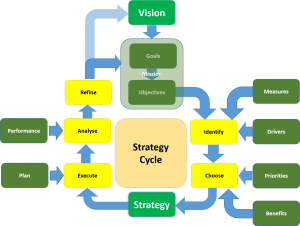Developing Enterprise Strategies
Blog: The Knowledge Economy
A strategy provides a way to describe how the business is going to get things done. It is much less specific than a plan, which describes who will do what and when. Instead, its purpose is to broadly answer the questions, “How do we get there from here?”; “What approach should we use?” and “Do we know if we have been successful?”
A good strategy will be cognisant of existing barriers and resources (people, money, capabilities, etc). It will also align with the vision, mission, goals and objectives of the business. A business may adopt multiple strategies (Business, Technology, Information, Marketing etc,), each with its own focus but maintaining consistency and alignment with one another, in order to best achieve its goals.
Objectives outline the aims of specific business initiatives and describe what success would look like in achieving the vision and mission. By contrast, a strategy will extend this by describing paths to take and how to move optimally along a road to success.
Why develop a strategy?
The act of developing a strategy provides a mechanism to focus the efforts of a business into deciding what needs to be done in order to realise its vision. In developing and applying a strategy, a business can achieve the following advantages:
- Improved efficiency in the use of its resources and processes.
- Increased responsiveness to emerging opportunities.
- Better identification and management of resistance and barriers to business.
Good distinctive sets of strategies should ensure that a business builds, maintains, and continually strengthens a specific identity in its marketplace.
Strategies become the nuclei around which business and ICT plans are developed. They also provide the framework supporting deviations from the plan and how these can be accommodated.
As well as providing a consistent view of the direction for key business areas, a good strategy should endure, providing continuity in transitioning any given year’s business plan into the next.
A strategy, by addressing multiple time horizons allows a business to readily build upon the accomplishments of the past, without losing sight of the future. Without a clearly defined and actioned strategy a business can easily lose sight of what is needed to achieve its vision. This can occur when it runs into ‘temporary difficulties’, experiences unanticipated change events, or even when ‘rogue management’ starts to ‘do its own thing’.
A business strategy provides:
- The foundation of a business plan.
- A framework supporting the governing day-to-day operations.
- A tool by which deviations from plan can be assessed.
In developing a business strategy an approach to be applied needs to be identified. An approach using techniques such as Innovation, acquisition or diversification can be influenced by:
- The defined and acknowledged corporate ethics of a business. Ethics define business behaviour.
- An identified need to engage in growth rather than purely cost containment.
- The risk profile to be applied. Acceptance of risk will affect business aggressiveness.
- The time horizons to be addressed. A short term focus can have adverse impact on long term success.
- The measures needed to assess success.
Criteria for developing a good strategy
- Be ever mindful of the vision goals and objectives to be achieved. A successfully implemented strategy will show demonstrable progress.
- Maximise the use of what is really known. This can be supported through the use of a knowledge repository such as may be found in a well maintained Enterprise Architecture.
- Provide direction. It should point out the overall path without dictating a particular narrow approach (e.g., using specific vendor solutions).
- Take advantage of current resources, capabilities and assets.
- Identify capability gaps that need to be filled.
- Embrace new opportunities.
- Acknowledge and be responsive to resistance or even opposition to change. Good strategies attract allies and deter opponents.
- Address identified issues and problems. Strategies must provide the connection between actions and the benefits to be delivered by a successful implementation.
- Choose and prioritise initiatives so that maximum long term benefit can be achieved. Avoid the trap of identifying and implementing the ‘quick win’ without first assessing the impact on the long term benefits (or liabilities) that may result.
- Be clear enough that manageable and unambiguous plans can be formulated.
- Allow for a feedback loop. No strategy can remain static. Events will occur that affect outcomes. These may in turn affect the vision, mission, goals and objectives of a business. Change can consequently affect both the approach and the priorities of initiatives to be undertaken.
Strategy within the Enterprise is a critical tool to ensuring success. Successfully developed, implemented and maintained, it ensures that a business remains faithful to its vision, minimising the possibility of straying into areas that should not be traversed.
Leave a Comment
You must be logged in to post a comment.








